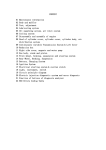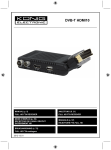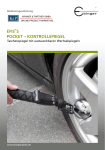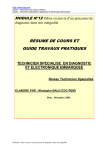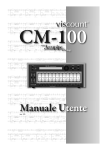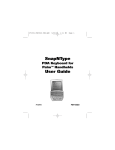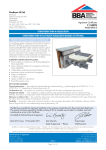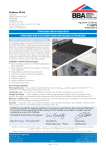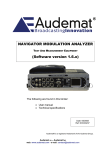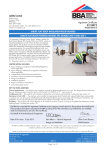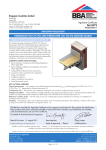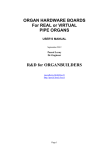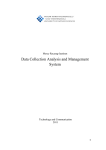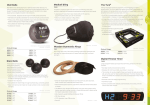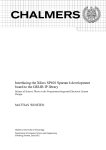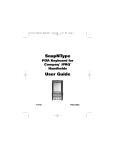Download organ documentation manual - GUPEA
Transcript
Organ documentation manual © GOArt and RAÄ 2005 ORGAn documentation manual Niclas Fredriksson, Alf Åslund, Carl Johan Bergsten Copyright: Göteborgs universitet, Göteborg Organ Art Center (GOArt) and Riksantikvarieämbetet (RAA) 2005 All rights reserved. No part of this publication may be reproduced or transmitted in any form or by any means, electronic or mechanical, including photocopying, recording, or by any information storage and retrieval system, without permission in writing from the copyright holders. Version 3.0 Table of contents 1. Introduction.................................................................................................... 6 2. The role of documentation...................................................................... 7 3. Measurement ACCURACY............................................................................. 9 4. Equipment......................................................................................................... 15 4.1 Equipment list ...................................................................................... 15 4.2 Special equipment handling......................................................... 16 4.2.1 Pipe wall thickness measurement with ultrasonic device............................................................................................................... 16 4.2.2 Pipe wall thickness measurement with thickness gauge............................................................................................................... 17 4.2.3 Measuring the languid angle and languid thickness....................................................................................................... 19 4.2.4 Measuring the windway width................................................. 19 5. Organ documentation and measurements.................................... 20 5.1 Documentation structure............................................................. 20 5.1.1 General............................................................................................. 20 5.1.2 Description...................................................................................... 21 5.1.3 Tables................................................................................................. 21 5.1.4 Drawings.......................................................................................... 21 5.1.5 Photo documentation............................................................... 22 5.2 Balcony.................................................................................................... 23 5.2.1 Moldings........................................................................................... 23 5.2.2 Panels................................................................................................. 23 5.2.3 Floor................................................................................................... 24 5.3 Case............................................................................................................. 25 5.3.1 Case structure............................................................................. 25 5.3.2 Moldings........................................................................................... 26 5.3.3 Carvings and pipe shades........................................................ 27 5.3.4 Doors and panels with ironwork....................................... 28 5.4 Keyboard area...................................................................................... 30 5.4.1 Manual keyboard....................................................................... 30 5.4.2 Pedal keyboard............................................................................ 32 5.4.3 Keyboard panels.............................................................................. 33 5.5 Key action............................................................................................... 35 5.5.1 Trackers and squares.............................................................. 35 5.5.2 Rollerboard.................................................................................. 37 5.6 Stop action.............................................................................................. 39 5.6.1 Stop knobs and stop rods........................................................ 39 5.6.2 Rollers, roller arms and roller beams, backfalls.................................................................................................. 40 5.7 Wind system............................................................................................ 41 5.7.1 Bellows............................................................................................. 41 5.7.2 Wind trunks incl. valves and tremulants.................... 43 5.8 Windchest................................................................................................ 44 5.8.1 General............................................................................................. 44 5.8.2 Pallet box........................................................................................ 46 5.8.3 Channel frame, channels and dividers......................... 46 5.8.4 Slider beds, sliders and spacers......................................... 47 5.8.5 Toeboards........................................................................................ 48 5.8.6 Pipe racks......................................................................................... 49 5.8.7 Façade and windchest layout, schematic of the windchest................................................................................................. 50 5.9 Pipe work.................................................................................................. 51 5.9.1 Flue pipes.......................................................................................... 51 5.9.2 Reed pipes.......................................................................................... 55 6. Data aquisition system.............................................................................. 57 6.1 General..................................................................................................... 57 6.2 Equipment................................................................................................ 57 6.3 Measurement setup............................................................................ 58 6.4 User manual........................................................................................... 59 6.5 Excel macros......................................................................................... 61 Appendix 1: Version updates........................................................................ 79 Appendix 2: Abbreviations in alphabetic order............................... 80 References........................................................................................................... 81 1. Introduction Background The documentation manual is in itself a documentation of results from the development of a documentation policy and methodology for historical organs at Göteborg Organ Art Center. The manual aims to describe how the organ documentation work of GOArt is performed; specifically, how the documentation reports are systematized and how they are to be interpreted, what is measured, how it is measured, what equipment is used, how the equipment is used, and what the various abbreviations refer to. The aim has been to attain a high level of verifiability, making it possible not only to examine and evaluate the method itself, but also to compare of the results obtained with results of other similar documentations. Purpose of the manual The documentation manual has several purposes: • Reference document for internal use. • Attachment to documentation reports. • To be used in documentation education. Living document This is not a final version of the documentation manual. The manual is updated as the GOArt documentation methods and methodology will develop. Each version of the manual is identified by its version number. The updates and changes between the versions are described in Appendix 1: Version updates. 2. The role of documentation The documentation of an organ has several important purposes: • To serve as an empirical basis for future comparative studies of organ construction, pipe-making and voicing techniques. • To enable organ builders and scholars to study and even to reconstruct the organ concerned directly from the documentation. • To assist in the formation of a thorough preservation and maintenance program for each instrument in order to help protecting the instrument against future arbitrary and sometimes less careful disassembly, measuring and study. • To help to safeguard the artifact in case of future damage. To enable the role of documentation described above it is obvious that the documentation has to be more exhaustive, more detailed and accurate than earlier documentation practice. limitations of the method This manual presents a systematic description of a method for documenting organs. The aim of the documentations created using this method is twofold: to safeguard essential information about the organs and to be able to convey that information over time and distance. It illustrates how quantifiable single parts of organs can be measured and described in a systematic way. The method mainly generates information about the outer framework within which the particular parts of an organ work together. The quantifiable properties constitute the obvious basic preconditions for this interaction. Already in documenting this outer framework several methodological problems arise. The manual should be seen as a first attempt to systematize and describe these preconditions and methodological problems. The intention is to gradually extend and deepen the content of this manual. Considering the problems that arise generally already when dealing with an organ’s quantifiable elements, the distance to the final goal can seem endless. Describing the qualitative aspects that arise out of the complex interplay between these quantifiable elements is, naturally, even more complicated. Nevertheless, the aim of this manual is to be a tool to help reach - the-virtually utopian-goal of gathering and conveying information and knowledge about organs to the extent and quality that they can be reconstructed from the documentation alone. In future updates of this manual the aim is to deal with more qualitative aspects of organs, as well as more fundamental questions about ethics in documentation and restoration of organs. A fundamental prerequisite for the documentation work is that tools as well as methods are non-destructive. They must under no circumstance endanger the artifacts, that is to say, that material may neither be removed nor deformed. This also applies to surfaces, such as solder size and pipe varnish, glue joints in wooden constructions and layers of paint. If destructive documentation methods are to be applied an exhaustive attention to matters of ethics is required. In principle, any method that can harm the objects is prohibited; preserving the objects takes precedence before data collection. A great importance is also attached to the reliability of the measurement values that are obtained. This means, for example, that the aim always should be to identify and minimize the sources of error and the amounts of deviation error in the methodology. The origins of these errors should also be identified whether they are due to the manufacturing process, the recording and reading of data or the handling of data, or some other origin. The intrinsic values of the artifacts and the reliability of the collected data is of greater importance than the amount of collected data! Measurements are almost always given in millimeters (usually with two decimals). This, however, may give a false impression of the degree of precision of the manufacturing process. This is true for example for beams in balconies and case structures, and also for wall thicknesses when measuring pipes that are coarsely scraped or scraped only on one side of the sheet. The reason for giving the measurements in millimeters (even when, from the standpoint of tolerance, mm are less appropriate, or even “incorrect”) is that a monotonous reformatting of measured values in the computer constitutes a source of error and also that consistently using only one routine for reading data from millimeter-graded tools could reduce the risk for misreading. When analyzing and using the obtained values it is, therefore, of the utmost importance to keep this in mind and to relate them to other essential factors, such as measuring method, measured item, precision of manufacturing process, material-technical characteristics, technical status, etc. Thus, all obtained values must be scrutinized and must not be taken too “literally.” Experience shows that the margins of error in the measuring methods themselves are usually smaller than the ones for the manufacturing and those due to the human factor. The latter might consist of errors in reading and typing data, sorting pipes in an incorrect way, etc. From a measuring-technical viewpoint, some of the methods used produce data of a more approximate character, while others give data that are more accurate than what might be interpreted as “relevant.” 3. Measurement accuracy Introduction When measuring for example the length of an object, it is important to know how well the measurement value represents the reality or the truth. Therefore it is necessary to make an estimation of the maximum difference between the measured length and the real length, i.e. the measurement inaccuracy. The inaccuracy consists of a combination of errors caused by the measuring method, by the measuring device and when reading the measurement value. The requirement on the accuracy can also vary depending on the purpose of the measurement. When documenting pipes in order to better understand the underlying pipe design idea, it is important to know that the sum of the possible deviations and errors, generated from design document to produced pipe including the measurement errors when documenting the pipes, is not of the same magnitude as significant differences depending on the design. Therefore a measurement test has been performed to map the deviations from design intention to produced pipes and also to estimate the accuracy one can expect when measuring the circumference of pipes. Measurement setup Three persons, experienced in documentation of pipe dimensions, measured the body circumference for each of the pipes c0-f3 in a newly produced Gedackt 8’ stop. Each person measured one circumference per pipe through the whole stop and repeated this three times resulting in three measurement series per person. They performed the measurements independent of each other. Fig. 1 When all pipe circumferences were marked on the strip, the circumferences were measured using a 300 mm long steel ruler, measuring the distance from the strip end to the different markings (Fig 2). Fig. 2 10 Results To map deviations from design intention to produced pipes the process can be divided into two steps: (i) Design width – sheet width and (ii) sheet width – body circumference. Design width – sheet width Figure 3 shows for the c0-f3 pipes, the sheet width from the design drawing and the measured width of the cut sheet when making the body. The width was measured using a 300 mm long steel ruler. Fig. 3 The pipemaker has marked and cut the sheet according to the measured width on the drawing. The graph shows a deviation for the ds0, e0 and f0 pipes with a maximum of 5 mm (ds0). The deviations could originate from measuring on the drawing, marking or cutting the sheet. Sheet width – body circumference Figure 4 shows for the c0-f3 pipes, the measured sheet width and the measured pipe body circumference. The circumference value is the mean value of the 9 measurement series from the test. It is obvious that the measured circumference is always slightly larger than the sheet width. There are several reasons for this. Bending the sheet to cylinder form will stretch the material at the outer surface and compress the material at the inner surface. When bending the sheet to a cylinder there will be a small distance between the meeting edges. This gap will be filled when soldering the pipe body. The thickness of the measuring strip and also the protruding solder seam will give addition to the circumference. In order to estimate the circumference deviation caused by bending the sheet and the measuring strip thickness, consider the following calculations and Figure 5. 11 Fig. 4 Fig. 5 12 Cs = sheet width Cm = measured circumference d = theoretic diameter th = pipe wall thickness ts = measuring strip thickness gw = gap width Assuming that the gap width is small so that the cylinder cross section form can still be considered a circle and that the unaltered (not expanded or compressed) part of the sheet is located in the center: d = Cs/π Cm = (d + th + 2*ts)*π + gw = (Cs/π + th + 2*ts)*π + gw Cm = Cs + π*th + 2*π*ts + gw Cm-Cs = π*th + 2*π*ts + gw ts= 0.06 mm Cm-Cs = π*th + 0.38 + gw One part of the deviation between the measured circumference and the sheet width is proportional to the sheet thickness. This tendency is also visible in the Figure 6 where the difference between circumference and sheet width together with the thickness are shown. It is not possible to know how much of the material is compressed or expanded when bending the sheet but calculating the minimum deviation (the material is only compressed) and the maximum deviation (the material is only expanded) gives following result: dev = Cm-Cs devmin < dev < devmax where devmin = 2*π *ts + gw = 0.38 + gw devmax = 2*π *th + 2*π *ts + gw = 2*π *th + 0.38 + gw Measurement accuracy The measurement errors can be divided into two categories: Systematic and random errors. A systematic error always gives a specific positive or negative contribution to the value. A random error vary from measurement to measurement and characteristic for a random error is that it can be reduced by repeating the measurement and calculating the mean value; the more repeated measurements the smaller random error. Measuring the circumference is divided into two steps: (i) Winding the strip and marking the circumference and (ii) measuring the mark position on the strip using a ruler. The first step contains a systematic error depending on the strip thickness (see above) and also maybe because the strip can slip down a little on one side when winding it around the pipe body. This error gives an addition to the circumference. Both steps also will give random errors. In a pipe documentation situation it is most often not possible to repeat the circumference measurements and it is important to estimate the spread for a single measurement value. Figure 7 shows the differens bet- 13 ween a single value and the mean value (based on all 9 values per pipe) for all 9 (3 per person) measurement series. Figure 7 indicates the expected spread to be within –0.5 mm to +0.7 mm. The value variations are somewhat larger for larger pipes compared to smaller pipes. A possible reason could be that the strip easier can slip down a little on one side when winding it around a larger pipe body. A way to improve this would be to use wider strips. Conclusions When making sheets based on the design drawing for pipe body production, deviations can originate from measuring on the drawing, marking or cutting the sheet. In the test a deviation was measured for a couple of sheets with a maximum of 5 mm. The measured pipe body circumference is always slightly larger than the corresponding sheet width. The deviation is partly dependent on the sheet thickness and it is less than 2*π *(th + ts) + gw where th = pipe wall thickness ts = measuring strip thickness gw = soldering gap width The measurement test indicates that the expected inaccuracy when measuring the circumference is about +0.7 to –0.5 mm. The accuracy could probably be slightly improved by using a little wider measuring strip than the 3 mm wide strip used in the test. Fig. 6 14 Fig. 7 15 4. Equipment 4.1 Equipment list Electronic Measuring Devices • Ultrasonic thickness gauge (Krautkramer Branson, Model DMS) • Sound frequncy measuring device Optical Inspection Devices • Inspection mirrors (Heine, mini-Kontrollspiegel) • Medical ear inspector (Heine, mini-Boroskop) • Boroscope, 0°, 90°, 110° optics Electronic Equipment with Direct Computer Input • Vernier callipers (Mitutoyo, 573-125-10, NTD12P-15C) • Thickness gauge (Mitutoyo, Absolute, 543-681B) Traditional Hand Tools • Measuring tapes (Stanley), in millimeters; having 3 and 50 meters length, respectively • Vernier callipers, with tenths of millimeters • Folding rule (Hultafors) • Rulers of various lengths in millimeters and half-millimeters • Combination square (Stanley) • Telescope stick (Nedo, ”Essfix,” 5 meter, with rule in millimeters) Special Hand Tools • Profiler (”R.G.R:, Conformateur,” 150 mm measurement length, 100 mm measurement depth, having a scale thickness of 0.3 mm. • Languid angle ”duplicator,” specially-made plastic film shaper with angles of 45°–90°. • Paper strips, for windway determination, of 80-gram paper with printed, black lines of various widths. The line widths are 0.25, 0.30, 0.35, etc. up to 0.95 and 1.00 mm. • Paper rulers, specially-made with half-millimeter marks printed on 80-gram paper strips. • Foil strips, made from transparent drawing film of 0.03 mm thickness and in some cases of 0.07 mm thickness. • U-bend wind pressure measuring device. Photographic Equipment • Traditional camera with various lenses, etc. • Digital camera, (Nikon Coolpix 4500) 16 4.2 Special equipment handling 4.2.1 Pipe wall thickness measurement using ultrasonic device Measuring method The method is based on transferring a high frequency sound pulse into the pipe wall. Every change of the sound conductivity in the material will give rise to a sound reflection. Sound with this high frequency cannot travel in air, so the sound pulse will travel back and forth in the pipe wall a number of times (Fig. 8). The pulse will gradually lose its energy and disappear. By listening to these reflected sound pulses and measuring the time between two echoes, it is possible to calculate the wall thickness. For this calculation it is necessary to know the sound velocity in the metal. Sound velocity can be found in the literature for many metals, but in our case we are measuring in an alloy where the exact content relation between the metals (lead, tin, and trace elements) most often is not known at the time of documentation. Therefore it is necessary to determine the velocity by a calibration procedure. Measurement setup Sound with the frequency 15 MHz is transmitted into the metal. Since the sound cannot travel in air, it has to be sent from the sound-generating element into the metal through a so-called couplant. There are couplants consisting of high viscosity liquids or gels specially developed for this purpose. It is also possible to use water as a couplant; we chose to use water in order not to risk affecting the metal surface. Just a small amount of pure water on the ultrasonic sensor tip is sufficient to transfer the sound from the sensor into the pipe wall. The measurement is calibrated by determining the sound velocity in the metal. For pure lead the sound velocity is ca. 2200 m/s, and for pure tin the velocity is ca. 3300 m/s. For lead-tin alloy the sound velocity is somewhere between these two values. First the wall thickness is measured at the top of the pipe using a mechanical measuring device. From measuring the wall thickness at the same spot using the ultrasonic instrument, the sound velocity can be calculated. Knowing the velocity, it is also possible to get an idea of the approximate content relation between lead and tin in the alloy. Fig. 8 The wall thickness is measured at several places on the pipe: at the pipe foot bottom and top (same level as the lower lip), and at the pipe body bottom (same level as the upper lip) and top. For longer pipes, the thickness is also measured on the pipe body middle level, and sometimes also at 1/4 and 3/4 of the body length. On each level the thickness is measured in three or in five positions (depending on the size of the pipe) along the pipe circumference. 17 4.2.2 Pipe wall thickness measurement using thickness gauge Wall thicknesses are mecanically (“Wall Th. (mec.)”) measured with a thickness gauge. Its curved leg is inserted into the pipe, and its movable leg lies perpendicular to the surface of the outside of the pipe, see Fig. 9. The ends of the legs are rounded, with a diameter of 2.9 ±0,1 mm on the moving leg and 2.8 ±0,1 mm on the curved leg. Fig. 9 When measuring wall thickness on flat surfaces the rounding of the legs does not influence the measurement. However, when measuring curved surfaces, like cylindrical or conical pipe bodies or more or less coned foot tips, there is an introduction of error as can be understood from Figure 10; this is a result of the concavity of the cylinders inside. The effect of the curvature can be compared to measuring with a micrometer (see Fig. 10); the inner leg doesn´t lie close to the pipe wall, resulting in either an erroneous value or deformation of the wall. The intention is to perform tests and analyses of this phenomenon, and to account for it in a future update of this manual. It can already be stated, though, that the the ultrasonic wall thickness measuring device (see p. 17) is calibrated using the values obtained from measurements taken with the thickness gauge. (On several occasions when documenting organs, distinct traces of previous documentations have been detectable. The assumption that these traces are results of previous documentations is derived from the fact that these traces are found most often in c pipes, and in some cases in f, f# and g pipes. The traces consists of circular imprints, with a diameter of 3-5 mm. at the orifices of the pipe bodies (= “Body T,” “Body C,” or “Body M”). In short: all this shows the destructive effects of micrometers, which therefore should not to be used in organ documentation activities.) This effect occurs when the radius of the concave surface is smaller than the radius of the end of the leg of the thickness gauge. This has been confirmed in tests performed by Niclas Fredriksson and Mats Arvidsson in the workshop of the latter. In these tests four new metal sheets with different thicknesses, all with an alloy of 1:5 were used. Their thicknesses were measured before they were rounded, at a position indicated with a marker pen. Then the sheets were rounded using nine different mandrels with diminishing diameters, ranging from 40 mm. to 4 mm. The wall thickness was measured after each change of the cylinders inner diameter. 18 Fig. 10 The resulting measurements (see table below) shows that the source of error when using this device on rounded metal sheets is essentially negligible from a practical point of view; pipes with an inner diameter of less than five mm. hardly ever, or very rarely, occurs.The deviations in the test results are probably due to slightly different amount of force being applied when positioning the thickness gauge. This test was caused by experiences in GOArt´s organ research workshop in connection with the North German Organ Research Project and the Vilnius/Rochester project. Pipes made after documentations following the principles presented in this publication ended up having considerably thicker walls than the originals. According to the test results presented here the reason for these differences is not depending on the documentation method. One possible source of error could stem from interpretation, both when analyzing the documentation, and in the manufacturing process. Possibly in both these stages a tendency to round and interpret the figures ”generously” is present, this to ensure that the walls in the copies get ”sufficient” static properties. 19 4.2.3 Measuring the languid angle and languid thickness The device for measuring the languid angle (see Fig. 11) is made of a 0.25 mm thick plastic foil, that has to be rigid enough to be functional but soft enough that it doesn´t cause any scratches or other damage. Different pieces with angles ranging from 40° to 90° are needed. The upper edge should rest flush with the upper side of the languid and then the documenter has to find the piece that matches the languid angle. The device for measuring the languid thickness (see Fig. 11) is held parallel to the vertical middle line of the pipe and-as close as possible-at a 90° angle to the underside of the languid. The measurements obtained when using these two devices must be seen as approximations of the actual dimensions. Considering the fact that the undersides of the languids can be positioned below the upper edge of the lower lip (which is especially true of covered pipes) and the fact that counterfaces resulting from either the production or nickings can be present, the values of the languid thicknesses should be seen as minimum values. Fig. 11 and Fig. 12 4.2.4 Measuring the windway width A special device is used for measuring windway widths and wall thicknesses of lower lips (see Fig. 12) : printed black lines of different widths printed on a plastic foil (compare with the description of the device for measuring the languid angles). They are wedge shaped. The printed lines run parallel to the blunt end of the wedge. The wedge is gently put on top of the upper edge of the lower lip and the measurements of either the windway width or the wall thickness of the lower lip is taken by comparing these with the printed lines. Also here, the values obtained should be regarded as approximations. 20 5. Organ documentation and measurements 5.1 Documentation structure 5.1.1 General Each documentation comprises the following main items: • Verbal description • Tables • Drawings and sketches • Photographs A fundamental principle of the documentation work is that all of the elements are presented from the standpoint of their current placement and function in the organ at the time of the documentation (this principle also applies to stop names). Elements that are obviously later additions are treated lastly in each of the main items. In each main item, the information is sorted and ordered to as high a degree as possible according to the same basic scheme: that the reader approaches the organ from the outside and then into each of the individual sections of the organ. Each individual documentation, unless otherwise mentioned, has had its corresponding measurements taken with the same measuring technique. Joint techniques used in the instrument are presented in the description and/or indicated in the drawings (e.g. dovetail, plug, mortice and tenon, lap joint). See Fig. 13. Fig. 13 21 5.1.2 Description An overview of the history of the instrument is given in a special chapter at the beginning of each documentation report. In the following written description, the organ is introduced with a description of its placement, its specification, inscriptions found during the documentation work (when applicable), and the balcony. When describing the location and orientation, reference to the four cardinal points are made. Thereafter, more exhaustive descriptions are given of the case, moldings, carvings, doors, panels, etc. The key desk is then described, followed by descriptions of the key action and the stop action, from the keyboard to the windchests. The description continues in a similar fashion, presenting again the organ from the outside and going inside, but this time following pathway of the wind through the organ: transmission into the organ via the bellows, through the wind trunks, Sperrventil[s], tremulant[s], windchest[s], and lastly, the pipework. The pipework is described in the order in which the pipes are placed on the windchest[s], beginning with the façade pipes and proceeding backwards. Annotations and letters found in sketches and drawings are explained in the description. Supplementary comments to the various constructions are given, etc. It is the primary aim of the documentation work to document the instrument’s technical function, which means that more in-depth archival research has not been done. In several instances, certain information and documents are referred to since they are easy to access and have relevance to the documentation presented. 5.1.3 Tables Lengthy series of measurements have been stored in Excel documents, making it possible to process and analyze the information. All of the measurements given in the tables are in millimeters, except for the thicknesses of the material, which are given in hundredths of millimeters. When recording a specific value in connection with several, usually three, measurements of the same type being taken, the average value is shown first in the tables, followed by those values upon which the average was calculated. Any instances where this is not the case are evident from the formatting of the columns in the tables. Certain measurements are absent from the tables, mainly because the pipe in question was damaged, repaired, or the like. In certain cases (uneven inner surface of the cast sheet or high lead-content, thick sheet), it was either difficult or impossible to obtain unambiguous values; consequently, the values were intentionally left out to increase the trustworthiness of the documentation results. An additional main reason for abstaining from certain measurement procedures is that damages to the pipes, particularly with regards to voicing, under no circumstances should be risked. In the measuring of the pipe material thicknesses with ultrasonic equipment, the distance between the measurement positions were in no case shorter than approximately one foot or one pipe-foot length, which means that pipes of one-foot length or less have been measured at only one position of the body, namely at the upper lip, also known as the “bottom” of the pipe body. Pipes of 8’ length or longer have been measured as shown in figure 51. The results of the ultrasonic measurements are given separately in one table common to all of the stops. Figure 51 shows that the position indications for taking the measurements of the pipes comes from the idea that the observer “identifies” him- or herself with the pipe. 5.1.4 Drawings A basic principle of the documentation has been that all the measurements from which the drawings were made are given in the respective drawings. 22 The only drawing on which the measurements are not given is the first: the drawing of the façade, one-half with details and the other half showing only the fundamental structure. These drawings can be seen as the sum total of the respective documentation and have been created from the other fundamental information. Full-scale contoured tracings are sometimes made of all of the carvings; for practical reasons, however, the tracings have not been published in the original format but have been proportionally reduced and then inserted into the drawings. All of the measurements are given in millimeters. Measurement indicators (in the form of adjacent bracket-like lines with corresponding measurements) are as a rule placed at the end of the object where the measurements were taken. Measurements placed in square brackets are calculated from the given measurements in the adjacent measurement indicators. In cases where measurements are not possible to take, the dimensions of the object are estimated and drawn free-hand without measurements being indicated. ”Interval measurements” appear deliberately. This is a safety precaution (measuring can be detected by means of the adjacent measurement indicators) and at the same time, it gives information about irregularities in the constructions. Discrepancies, regarding the total sums, between the adjacent measurement indicators and the total measurements are in some cases obvious; such discrepancies derive primarily from distortions and irregularities in the constructions, and to a lesser extent from the measuring method and aspects of measurement interpretation. All of the sketches are executed according to scale, but in free-hand in order to give a suggestion that not all of the discrepancies, damages, etc. are rendered with pin-point accuracy. The main purpose of the sketches is to give an idea of the original intention behind the handiwork for each individual element. The drawings having a 1:1 scale usually present traced objects; therefore, usually no, or only a few, reference measurements are given. The scales used in the original drawings and sketches are indicated in the overview of the respective category of drawings. The original drawings and sketches are made on large paper sheets (A3 size). The grain direction is schematically indicated in the drawings (Fig. 14). Fig. 14 5.1.5 Photo documentation Thorough photographic documentation of all of the details are presented in order to reveal information about the surface treatment, scraping-mark direction, solder seam character, etc. 23 5.2 Balcony 5.2.1 Moldings Measurements Drawings with basic measurements showing the moldings positions. Profile drawings containing measurements (Fig. 19) It is important to take into consideration the profile change due to the painting of the moldings. Methods Manual measuring using profiler, vernier calliper, steel ruler. 5.2.2 Panels Measurements Drawings with measurements of doors and panels (Fig. 21). Drawings with measurements of the ironwork (Fig. 22). Methods Manual measuring using measuring-tape, folding rule and vernier calliper. Fig. 15 Fig. 16 24 5.2.3 Floor Measurements Drawings with basic measurements (Fig. 15-16), showing the organ position (Fig. 17). Mesurements of historical traces. Methods Manual measuring using telescope stick, measuring-tape, folding rule and vernier calliper. Fig. 17 25 5.3 Case 5.3.1 Case structure Measurements Drawings containing measurements (height, width, depth) of frames and beams constituting the case structure (Fig. 18). Methods Manual measuring using telescope stick, measuring-tape, folding rule and vernier calliper. Fig. 18 26 5.3.2 Moldings Measurements Drawings showing the moldings positions. Profile drawings containing measurements (Fig. 19) It is important to take into consideration the profile change due to the painting of the moldings. Methods Manual measuring using profiler, vernier calliper, steel ruler. Fig. 19 27 5.3.3 Carvings and pipe shades Measurements Drawings with basic measurements (Fig. 20). Photo documentation. Tracing. Methods Manual measuring using measuring-tape, folding rule and vernier calliper. Taking photographs using conventional or digital camera. Fig. 20 28 5.3.4 Doors and panels with ironwork Measurements Drawings with measurements of doors and panels (Fig. 21). Drawings with measurements of the ironwork (Fig. 22). Methods Manual measuring using measuring-tape, folding rule, steel ruler and vernier calliper. Fig. 21 29 Fig. 22 30 5.4 Keyboard area 5.4.1 Manual keyboard Measurements Drawings with basic measurements of the keyboard frame and key cheeks. Tracing of profiles. Balance-pins positions and sizes. Drawing and table with measurements of keys and key covers (Fig. 23-25). Octave widths for: C-H, c-h, c1h1, c2-h2. Methods Manual measuring using measuring-tape, folding rule, steel ruler and vernier calliper. Fig. 23 Fig. 24 31 Fig. 25 32 5.4.2 Pedal keyboard Measurements Drawings with basic measurements of the pedals (Fig. 26), pedal keyboard frame (Fig. 26), the pedal keyboard guide and the pedal frame back rail. Tracing of pedals and the frame side. Methods Manual measuring using measuring-tape, folding rule, steel ruler and vernier calliper. Fig. 26 33 5.4.3 Keyboard panels Measurements Drawings with basic measurements of the keyboard panels (Fig. 27-28). Methods Manual measuring using measuring-tape, folding rule, steel ruler and vernier calliper. Fig. 27 34 Fig. 28 35 5.5 Key action 5.5.1 Trackers and squares Measurements Drawing with measurements of the trackers and squares (Fig. 29-30). The individual trackers lengths are not measured but the lengths are defined by the positions of the rollerboard, the keyboard and the windchest. Methods Manual measuring using folding rule, steel ruler and vernier calliper. Fig. 29 36 Fig. 30 37 5.5.2 Rollerboard Measurements Drawings with basic measurements of rollerboard (Fig. 31), rollers with roller arms, needle bearings and studs (Fig. 33). Rollerboard table (Fig. 32). Methods Manual measuring using measuring-tape, folding rule, steel ruler and vernier calliper. Fig. 31 and Fig. 32 38 Fig. 33 39 5.6 Stop action 5.6.1 Stop knobs and stop rods Measurements Drawings and tables with measurements of stop knobs and stop rods (Fig. 34-35). Methods Manual measuring using measuring-tape, folding rule, steel ruler and vernier calliper. Fig. 34 Fig. 35 40 5.6.2 Rollers, roller arms and roller beams, backfalls Measurements Drawings with measurements of rollers, roller arms (Fig. 36), roller beams and backfalls (Fig. 37). Methods Manual measuring using measuring-tape, folding rule, steel ruler and vernier calliper. Fig. 36 Fig. 37 41 5.7 Wind system 5.7.1 Bellows Measurements Drawings and tables with measurements of upper and lower board (Fig. 38), ledges, folds (Fig. 39-40), inlet valve, outlet valve, bellows frame, pumping levers. If possible, measurement of the wind pressure. Methods Manual measuring using measuring-tape, folding rule, steel ruler and vernier calliper. Wind pressure measuring device (e.g. U-bend). Fig. 38 42 Fig. 39 Fig. 40 43 5.7.2 Wind trunks incl. valves and tremulants Measurements Drawings with outside measurements and thicknesses of wind trunks (Fig. 41). Drawings of valves and tremulants (Fig. 42). Methods Manual measuring using measuring-tape, folding rule, steel ruler and vernier calliper. Fig. 41 Fig. 42 44 5.8 Windchest 5.8.1 General Measurements Drawings with basic measurements of the windchest. Methods Manual measuring using measuring-tape, folding rule, steel ruler and vernier calliper. Fig. 43 45 Fig. 44 46 5.8.2 Pallet box Measurements Drawings with measurements of bottom board, pouches, pallets, face board, pallet springs, spring rack (Fig. 43-44). Methods Manual measuring using measuring-tape, folding rule, steel ruler and vernier calliper. 5.8.3 Channel frame, channels and dividers Measurements Table with measurements of channel widths (Fig. 45). Methods Manual measuring using steel ruler and vernier calliper. Fig. 45 47 5.8.4 Slider beds, sliders and spacers Measurements Drawings and tables with measurements of slider beds, sliders and spacers (Fig. 46-47). Methods Manual measuring using measuring-tape, folding rule, steel ruler and vernier calliper. Measuring of borings using vernier calliper connected to the data aquisition system. Fig. 46 48 5.8.5 Toeboards Measurements Drawings and tables with measurements of toeboards (Fig. 46-47). Drawings / tracings with measurements of toeboard screws (Fig. 48). Methods Manual measuring using measuring-tape, folding rule, steel ruler and vernier calliper. Measuring of borings using vernier calliper connected to the data aquisition system. Fig. 47 Fig. 48 49 5.8.6 Pipe racks Measurements Drawings with measurements of pipe racks (Fig. 46) Table with measurements of pipe rack borings (Fig. 49). Methods Manual measuring using measuring-tape, folding rule, steel ruler and vernier calliper. Measuring of borings using vernier calliper connected to the data aquisition system. Fig. 49 50 5.8.7 Façade and windchest layouts, schematic of the windchest A-C and E-J in Fig. 50 gives distance from one end of the channel frame. I.b. and I.c. primarily give gap widths. A. façade division B. channel division giving distances to each channel center C. positions of pipe rack pillars D. number of pipe rack pillars at each position E. toeboard screws, distances to each channel center F. toeboards, distances to the center of respective toeboard joints G. catchers, distances to each catcher center H. faceboard (with a section of the middle faceboard inserted) I. pallet box, with channels and bars a. center b. total width c. outer width J. wind trunk entrances Fig. 50 51 5.9 Pipe work In the lists below, the column headings and abbreviations used in the tables are explained. These are given in the order in which they are to be found in the documentation tables for the organ. The measuring tool used for each parameter is indicated in italics. 5.9.1 Flue pipes Fig. 51 – metal pipe, and Fig. 52 – wood pipe 52 Main Title Subtitle Body Explanation and Method Pipe body. Circ. Av. Circumference average (bottom, middle, top) = the average value (B., M., T.) of the outer circumference measured on the lower part of the pipe body (just above the upper lip), in the middle, and at the top. Strip of drawing film, usually 0.03 mm thick, but in certain cases 0.07 mm thick. Calc. circ. B. Circumference, calculated from the value in the next nearest column, which is its average. Ø B. Av. (3) Average of three measurements of outer diameter, taken at the same position, just above the upper lip (the given values in the three adjacent columns). Vernier callipers. Ø T. Av. (3) Same as Ø B. (average of three), but at the end of the pipe. Length The longest length of the pipe body, measured from (Long.) the middle of the languid’s soldering seam to the end. Conical or funnel-shaped parts have been measured along the surface and are therefore not plumb (see the sketches of the pipe feet and the resonators). Ruler or measuring tape. Cap Cap. L. Length. Ruler or measuring tape. Calc. circ. Circumference, calculated from the value in the next nearest column. Ø Av. (3) Average of three measurements of outer diameter, taken at the same position, just above the upper lip (the given values in the three adjacent columns). Vernier callipers. Foot Pipe foot. L. Length, measured along the foot, therefore not plumb (see sketch). Ruler or measuring tape. Visual L. Length measurement parallel to the body’s center axle, from the top side of the toe board (or the offset block) to the middle of the languid seam. @ The values in the following columns are obtained from this given distance from the middle of the languid seam. Ruler or measuring tape. Toe Ø Av. (3) Average of three measurements of inner foot hole diameter taken at the same position (the given values in the three adjacent columns). Vernier callipers. 53 Wall Th. (100) Pipe material thickness, measured mechanical- mech. ly, expressed in hundredths of millimeters. Thickness gauge. Mouth C. Upper lip material thickness, taken at center. Body Top L. Material thickness at the end, left side. Body Top C. Material thickness at the end, at the middle front of the body. Body Top R. Material thickness at the end, right side. UL Upper lip W. Width. If the lips have been scribed, the measurement is taken at the center of the scribed lines. If the lips are only pressed, the actual width is measured unless the intended width is clearly detected. Ruler in half-millimeters or vernier callipers (depending on the alloy, stiffness, etc.). H. Height, taken from the lower edge of the upper lip (i.e., not from the languid seam or the lower lip’s upper edge). If the lips have been scribed, the measurement is taken at the center of the scribed lines. If the lips are only pressed the actual height is measured unless the intended height is clearly detected. Ruler in half-millimeters or vernier callipers (depending on the alloy, stiffness, etc.). Cut-up Cut-up. In cases where the upper lip has been changed and the cut-up lowered, the measurement specifies the distance between the soldering joint of the upper lip’s alteration and the lower lip’s upper edge. Consequently, this measurement must be used with caution, since the edges of the lips may have been “tidied up” more or less, before the lowering-piece was applied. Ruler in half-millimeters or vernier callipers (depending on the alloy, stiffness, etc.). M. orig. Cut-up, measured at the middle of the lips: the distance between the lower lip upper edge and the languid seam; measured between the original metal and the metal piece first soldered in for the lowering of the cut-up. M. sec. Cut-up, measured at the middle of the lips: the distance between the lower lip upper edge and the languid seam; measured between the metal piece first soldered in for the lowering of the cut-up and a second (additional) soldered-in piece also for cut-up lowering. M. pres. The present cut-up, measured between the second soldered-in piece’s lower edge and the lower lip’s upper edge. LL Lower lip. W. Width. See UL. Ruler in half-millimeters or vernier callipers (depending on the alloy, stiffness, etc.). 54 H. Height. See UL. Ruler in half-millimeters or vernier callipers (depending on the alloy, stiffness, etc.). Th. (100*) Thickness of lower lip, expressed in hundredths of millimeters. Paper strips with marks placed above the lip edge and its thickness is estimated (various inaccuracies are due to, for example, rounded/beveled outer and inner edges). Dist. Block Distance that the languid extends above the top of the cap. – LL Ww. W. (100*) Windway width, expressed in 100/1 larger than actual, measured in the middle. Measured in the same way as the lower lip thickness. Lang. Languid. Th. Thickness. Thin paper strip marked with half-millimeters. Ang. Languid angle. Nicks Number of nicks. Counterface Counterface. Beard Side beards. Ruler in half-millimeters or vernier callipers (depending on the alloy, stiffness, etc.). W. Width. H. Height. Pos. Position. Distance from the lower edge of the beard to the middle of the languid seam. Hook Position Measured from the top edge of the cap or the languid solder seam. 55 5.9.2 Reed pipes Fig. 53 Fig. 54 56 Main Title Subtitle Explanation and Method Wooden re- Wooden resonators. sonator Ruler in millimeters or a tape measure and a vernier callipers. Tot. L. Total length. W. I B. (OD) Width I taken at the B=bottom, OD=Outer Dimension. W. I T. (ID) Width I taken at the T=top, ID=Inner Dimension. W. (OD) B. @ Outer width at the bottom, measured from the given distance from the point of the foot (which is rounded). Toe hole I Toe hole measurement, I=the first of two or more. Vernier callipers. Block Block. Dist. 1–14 The distances appear in Fig. 37. Vernier callipers. Dist. 12 Diameter of the shaft in the block. Dist. 13 Inner diameter of the tube, at the bottom of the block. Dist. 14 Inner diameter of the tube, inside along the lower surface to Dist. 8. Shallot Shallot. Vernier callipers. Ø B. (OD) Diameter at the bottom, the outer dimension. Ø T. (OD) Diameter at the top, the outer dimension. Depth B. (OD) Depth, at the bottom, the outer dimension. Depth T. (OD) Depth, at the top, the outer dimension. Brass Th. Thickness of the brass (in certain cases, wood thickness). Cover plate Th. Thickness of the cover. L. Length. End Th. (Av.) Thickness of the plug in the end (estimated value). Dist. Distance from the shallot’s lower edge to the lower surface on the body; in other words, the lower surface of Dist. 9. Tongue Thickness of the tongue. Vernier callipers. W. B. Width, at the bottom. Th. B. Thickness, at the bottom. Th. T. Thickness, at the top. Th. (under wire) Thickness measured under the tuning wire; in other words, at about the middle of the tongue. Dist. Distance from the lower edge of the tongue to the lower edge of the shallot. 57 6. Data aquisition system 6.1 General The data aquisition system is based on a laptop computer and Microsoft Excel software. This makes it possible to type measurement values and observations into Excel tables direct on site at the organ. It is also easy to add columns to the tables when necessary. Several persons can work in parallel using their computers (Mac or PC) and it is easy to put all results together into one table afterwards. The final work is reduced to a minimum because the tables can be printed out as they are or they can be inserted into a documentation report. It is also possible to make a mathematical analysis of the measured data using the built-in functions in Excel. An organ database has been developed within GOArt and the documentation data can easily be moved from Excel tables into database tables. It is also possible to connect measuring equipments to the laptop computer for direct input of measurement data into Excel tables. This was implemented using the software Measure (a plug in software module for Excel which makes it possible to transfer data from the computer input channels to an Excel table) together with software functions in Excel (using macro functions and the software language Visual Basic). The concept is used when measuring: 1. Dimensions using a calliper. 2. Pipe wall thickness using the ultrasonic equipment (DMS). 3. Organ wind pressure dynamic behaviour and bellows characteristics. This solution makes it possible to transfer values from the measuring equipment to the documentation report without manual input, which saves time and eliminates the risk of typing errors. 6.2 Equipment The data aquisition system consists of the following parts: Laptop computer: Type: Toshiba Satellite Pro 4600 Serial No: 91368659G SS460-0 Software: Excel (Microsoft) Measure (National instruments) Excel documents with macros to enable the import of measurement values to the document. Interface: Type: Mitutoyo DMX 3 S/N: AB 040309 09 Remark: For connection of a calliper to the PC. Type: Foot switch (Mitutoyo) Remark: To trig the transfer of the measurement value from the calliper to the PC. Type: PC card DAQCard-1200 (National Instruments) No: 182880H-01 Remarks: For measuring analogue signals (i.e. wind pressure). 58 6.3 Measurement setup Fig. 55 Fig. 56 Fig. 57 59 6.4 User manual How to use the DMS (Fig. 58) and the Mitutoyo calliper together with a PC. General info The DMS and Mitutoyo Excel documents have a built in function which makes it possible to connect the DMS thickness measuring equipment or a Mitutoyo calliper direct to the PC and to transfer the measured values direct into the Excel spreadsheet. Using the DMS instrument Connect the DMS to the PC serial port using the DMS cable. Turn on the computer and start Excel. Use the DMS Excel document when you define the table. Do not forget to rename the document. 1. Select the cell where you want to store the first measured value. 2. Press “Ctrl+Shift+T”. 3. Answer the question about the “number of levels” you are going to use when you measure the pipe. 4. Start to measure and send the values from the DMS by pressing the “Send” pushbutton on the DMS. 5. If you want to quit the measuring or skip a value: press “Q” and answer the question. The computer will automatically calculate the mean value for each level and quit the measuring session when all levels on the pipe are measured. Repeat (1)-(5) for each pipe. Fig. 58 Troubleshooting If you send a value from the DMS but nothing happens in the spreadsheet: 1. Quit the measuring (see (5) above). 2. Select “Instruments” under the “Serial” menu. 3. Click on the “Test” button. 4. Send a value from the DMS. 5. Click on “Read Serial Port”. Now a character string should appear in the Receive field. If nothing happens: repeat (4) and (5). 6. Click on the OK button, return to the spreadsheet and start the measuring. If nothing happens or you get strange error messages quit and restart Excel. 60 Using the Mitutoyo calliper Connect the calliper to input no. 1 on the interface (white box with a pushbutton on top). Connect the interface to the PC serial port. Turn on the interface (pushbutton on the side of the box). Turn on the PC and start Excel. Use the Mitutoyo or the Mitutspecial Excel document when you define the table. Do not forget to rename the document. You can choose if you want to fill in the table by row or by column. The Mitutspecial document is a version where you can define an offset value. This offset value will be added to all measured values. This is useful when you use the calliper NTD12P-15C for inner diameter measurements. You set the offset value in the first statement in the macros in the sheets Modul1 and Modul2 (see the instructions in these sheets). Fill the table by row: 1. Select the cell where you want to store the first measured value. 2. Press “Ctrl+Shift+H”. 3. Start to measure and send the values from the calliper by pressing the “Data” pushbutton or the connected pedal. 4. If you want to change to next row: send a “0” value from the calliper. 5. If you want to quit the measuring or jump to another cell in the table: press “Q” and answer the question. Fill the table by column: 1. Select the cell where you want to store the first measured value. 2. Press “Ctrl+Shift+V”. 3. Start to measure and send the values from the calliper by pressing the “Data” pushbutton or the connected pedal. 4. If you want to change to next column: send a “0” value from the calliper. 5. If you want to quit the measuring or jump to another cell in the table: press “Q” and answer the question. Troubleshooting If you send a value from the calliper but nothing happens in the spreadsheet: 1. Quit the measuring . 2. Select “Instruments” under the “Serial” menu. 3. Click on the “Test” button. 4. Send a value from the calliper. 5. Click on “Read Serial Port”. Now a character string should appear in the Receive field. If nothing happens: repeat (4) and (5). 6. Click on the OK button, return to the spreadsheet and start the measuring. If nothing happens or you get strange error messages quit and restart Excel. When you use the pedal the light indicator on the interface will blink. 61 6.5 Excel macros Input from DMS instrument This is the Excel macro for direct transfer of measurement values into an Excel table from a DMS instrument. ‘ ‘ Dms1 Makro ‘ Makrot inspelat 1996-11-22 av Carl Johan Bergsten ‘ ‘ Sub Dms1() Dim result As Integer Dim res As Double Dim answer As String Dim R As Integer Dim C As Integer Dim N As Integer Dim M As Integer Dim L As Integer Dim K As Integer R = ActiveCell.Row C = ActiveCell.Column L = Application.InputBox(Prompt:=”Enter number of levels”, Type:=1) K = 4 * (L - 1) For M = 0 To K Step 4 For N = 0 To 2 Range(Cells(R, C + M + N), Cells(R, C + M + N)).Select result = Application.Run(“RunTask”, “Thickness”, “Blad1!a1”) If result = -1003 Then answer = Application.InputBox(Prompt:=”Enter q = quit program or just click OK = skip cell”, Type:=2) If answer = “q” Or answer = “Q” Then Exit Sub Else ActiveCell.Offset(R - 1, C + M + N - 1).Range(“A1”).Select End If Else For I = 1 To 50 Beep Next I ActiveCell.Replace What:=” “, Replacement:=”’”, LookAt:=xlPart, _ SearchOrder:=xlByRows, MatchCase:=True ActiveCell.Replace What:=”’”, Replacement:=””, LookAt:=xlPart, _ SearchOrder:=xlByRows, MatchCase:=False 62 ActiveCell.Replace What:=”.”, Replacement:=”,”, LookAt:=xlPart, _ SearchOrder:=xlByRows, MatchCase:=False res = ActiveCell.Value ActiveCell.Value = res Range(“A1”).Select Selection.NumberFormat = “0.00” Selection.Cut ActiveCell.Offset(R - 1, C + M + N - 1).Range(“A1”).Select ActiveSheet.Paste End If Next N ActiveCell.Offset(0, 1).Range(“A1”).Select ActiveCell.FormulaR1C1 = “=AVERAGE(RC[-3],RC[-2],RC[-1])” With Selection.Interior .ColorIndex = 24 .Pattern = xlSolid End With Next M Range(Cells(R + 1, C), Cells(R + 1, C)).Select End Sub 63 Input from calliper into table columns This is the Excel macro for direct transfer of measurement values into table columns from a calliper. ‘ ‘ Calipreadv Makro ‘ Makrot inspelat 1997-01-20 av Carl Johan Bergsten ‘ ‘ Kortkommando: Ctrl+Skift+V ‘ Private R As Integer Private C As Integer Private M As Integer Private N As Integer Sub Calipreadv() Dim result As Integer Dim res As Double Dim answer As String Dim I As Integer M = 0 N = 0 R = ActiveCell.Row C = ActiveCell.Column Do Do Range(Cells(R + M, C + N), Cells(R + M, C + N)).Select result = Application.Run(“RunTask”, “Caliper”, “a1:a1”) If result = -1003 Then ActiveCell.Offset(R + M - 1, C + N - 1).Range(“A1”).Select answer = Application.InputBox(prompt:=”Enter q = quit program or s = select cell”, default:=”s”, Left:=120, Top:=-95, Type:=2) If answer = “s” Or answer = “S” Then Set myCell = Application.InputBox(prompt:=”Select cell”, Left:=120, Top:=-95, Type:=8) myCell.Select Newposv Else If answer = “q” Or answer = “Q” Then Exit Sub End If End If Else ActiveCell.Replace What:=”01A+”, Replacement:=”’”, LookAt:=xlPart, _ SearchOrder:=xlByRows, MatchCase:=True ActiveCell.Replace What:=”01A-”, Replacement:=”’”, LookAt:=xlPart, _ 64 SearchOrder:=xlByRows, MatchCase:=True ActiveCell.Replace What:=”02A+”, Replacement:=”’”, LookAt:=xlPart, _ SearchOrder:=xlByRows, MatchCase:=True ActiveCell.Replace What:=”02A-”, Replacement:=”’”, LookAt:=xlPart, _ SearchOrder:=xlByRows, MatchCase:=True ActiveCell.Replace What:=”03A+”, Replacement:=”’”, LookAt:=xlPart, _ SearchOrder:=xlByRows, MatchCase:=True ActiveCell.Replace What:=”03A-”, Replacement:=”’”, LookAt:=xlPart, _ SearchOrder:=xlByRows, MatchCase:=True ActiveCell.Replace What:=”’”, Replacement:=””, LookAt:=xlPart, _ SearchOrder:=xlByRows, MatchCase:=False ActiveCell.Replace What:=”.”, Replacement:=”,”, LookAt:=xlPart, _ SearchOrder:=xlByRows, MatchCase:=False res = ActiveCell.Value ActiveCell.Value = res Range(“A1”).Select Selection.NumberFormat = “0.00” If ActiveCell.Value < 0.04 Then Exit Do If (ActiveCell.Value = 911) Or (ActiveCell.Value = 921) Or (ActiveCell.Value = 931) Then ActiveCell.Value = 0 Else Selection.Cut Do If Rows(R + M).Hidden = True Then M = M + 1 Else Exit Do End If Loop ActiveCell.Offset(R + M - 1, C + N - 1).Range(“A1”).Select ActiveSheet.Paste For I = 1 To 30 Beep Next I M = M + 1 End If End If Loop N = N + 1 65 M = 0 For I = 1 To 100 Beep Next I Loop End Sub ‘ ‘ Newposv Makro ‘ Makrot inspelat 1997-01-24 av Carl Johan Bergsten ‘ ‘ Sub Newposv() Dim result As Integer Dim res As Double Dim answer As String Dim Rnew As Integer Dim Cnew As Integer Rnew = ActiveCell.Row Cnew = ActiveCell.Column result = Application.Run(“RunTask”, “Caliper”, “a1:a1”) If result = -1003 Then Else For I = 1 To 30 Beep Next I ActiveCell.Replace What:=”01A+”, Replacement:=”’”, LookAt:=xlPart, _ SearchOrder:=xlByRows, MatchCase:=True ActiveCell.Replace What:=”01A-”, Replacement:=”’”, LookAt:=xlPart, _ SearchOrder:=xlByRows, MatchCase:=True ActiveCell.Replace What:=”02A+”, Replacement:=”’”, LookAt:=xlPart, _ SearchOrder:=xlByRows, MatchCase:=True ActiveCell.Replace What:=”02A-”, Replacement:=”’”, LookAt:=xlPart, _ SearchOrder:=xlByRows, MatchCase:=True ActiveCell.Replace What:=”03A+”, Replacement:=”’”, LookAt:=xlPart, _ SearchOrder:=xlByRows, MatchCase:=True ActiveCell.Replace What:=”03A-”, Replacement:=”’”, LookAt:=xlPart, _ SearchOrder:=xlByRows, MatchCase:=True 66 ActiveCell.Replace What:=”’”, Replacement:=””, LookAt:=xlPart, _ SearchOrder:=xlByRows, MatchCase:=False ActiveCell.Replace What:=”.”, Replacement:=”,”, LookAt:=xlPart, _ SearchOrder:=xlByRows, MatchCase:=False res = ActiveCell.Value ActiveCell.Value = res Range(“A1”).Select Selection.NumberFormat = “0.00” If (ActiveCell.Value = 911) Or (ActiveCell.Value = 921) Or (ActiveCell.Value = 931) Then Else Selection.Cut ActiveCell.Offset(Rnew - 1, Cnew - 1).Range(“A1”).Select ActiveSheet.Paste answer = Application.InputBox(prompt:=”Enter b = go back or c = continue”, default:=”c”, Left:=120, Top:=-95, Type:=2) If answer = “c” Or answer = “C” Then R = Rnew C = Cnew M = 1 N = 0 End If End If End If End Sub 67 Input from calliper into table rows This is the Excel macro for direct transfer of measurement values into table rows from a calliper. ‘ ‘ Calipreadh Makro ‘ Makrot inspelat 1997-01-14 av Carl Johan Bergsten ‘ ‘ Kortkommando: Ctrl+Skift+H ‘ Private R As Integer Private C As Integer Private M As Integer Private N As Integer Sub Calipreadh() Dim result As Integer Dim res As Double Dim answer As String Dim I As Integer M = 0 N = 0 R = ActiveCell.Row C = ActiveCell.Column Do Do Range(Cells(R + M, C + N), Cells(R + M, C + N)).Select result = Application.Run(“RunTask”, “Caliper”, “a1:a1”) If result = -1003 Then ActiveCell.Offset(R + M - 1, C + N - 1).Range(“A1”).Select answer = Application.InputBox(prompt:=”Enter q = quit program or s = select cell”, default:=”s”, Left:=120, Top:=-95, Type:=2) If answer = “s” Or answer = “S” Then Set myCell = Application.InputBox(prompt:=”Select cell”, Left:=120, Top:=-95, Type:=8) myCell.Select Newposh Else If answer = “q” Or answer = “Q” Then Exit Sub End If End If Else ActiveCell.Replace What:=”01A+”, Replacement:=”’”, LookAt:=xlPart, _ SearchOrder:=xlByRows, MatchCase:=True ActiveCell.Replace What:=”01A-”, Replacement:=”’”, LookAt:=xlPart, _ 68 SearchOrder:=xlByRows, MatchCase:=True ActiveCell.Replace What:=”02A+”, Replacement:=”’”, LookAt:=xlPart, _ SearchOrder:=xlByRows, MatchCase:=True ActiveCell.Replace What:=”02A-”, Replacement:=”’”, LookAt:=xlPart, _ SearchOrder:=xlByRows, MatchCase:=True ActiveCell.Replace What:=”03A+”, Replacement:=”’”, LookAt:=xlPart, _ SearchOrder:=xlByRows, MatchCase:=True ActiveCell.Replace What:=”03A-”, Replacement:=”’”, LookAt:=xlPart, _ SearchOrder:=xlByRows, MatchCase:=True ActiveCell.Replace What:=”’”, Replacement:=””, LookAt:=xlPart, _ SearchOrder:=xlByRows, MatchCase:=False ActiveCell.Replace What:=”.”, Replacement:=”,”, LookAt:=xlPart, _ SearchOrder:=xlByRows, MatchCase:=False res = ActiveCell.Value ActiveCell.Value = res Range(“A1”).Select Selection.NumberFormat = “0.00” If ActiveCell.Value < 0.04 Then Exit Do If (ActiveCell.Value = 911) Or (ActiveCell.Value = 921) Or (ActiveCell.Value = 931) Then ActiveCell.Value = 0 Else Selection.Cut Do If Columns(C + N).Hidden = True Then N = N + 1 Else Exit Do End If Loop ActiveCell.Offset(R + M - 1, C + N - 1).Range(“A1”).Select ActiveSheet.Paste For I = 1 To 30 Beep Next I N = N + 1 End If End If Loop M = M + 1 69 N = 0 For I = 1 To 100 Beep Next I Loop End Sub ‘ ‘ Newposh Makro ‘ Makrot inspelat 1997-01-24 av Carl Johan Bergsten ‘ ‘ Sub Newposh() Dim result As Integer Dim res As Double Dim answer As String Dim Rnew As Integer Dim Cnew As Integer Rnew = ActiveCell.Row Cnew = ActiveCell.Column result = Application.Run(“RunTask”, “Caliper”, “a1:a1”) If result = -1003 Then Else For I = 1 To 30 Beep Next I ActiveCell.Replace What:=”01A+”, Replacement:=”’”, LookAt:=xlPart, _ SearchOrder:=xlByRows, MatchCase:=True ActiveCell.Replace What:=”01A-”, Replacement:=”’”, LookAt:=xlPart, _ SearchOrder:=xlByRows, MatchCase:=True ActiveCell.Replace What:=”02A+”, Replacement:=”’”, LookAt:=xlPart, _ SearchOrder:=xlByRows, MatchCase:=True ActiveCell.Replace What:=”02A-”, Replacement:=”’”, LookAt:=xlPart, _ SearchOrder:=xlByRows, MatchCase:=True ActiveCell.Replace What:=”03A+”, Replacement:=”’”, LookAt:=xlPart, _ SearchOrder:=xlByRows, MatchCase:=True ActiveCell.Replace What:=”03A-”, Replacement:=”’”, LookAt:=xlPart, _ SearchOrder:=xlByRows, MatchCase:=True 70 ActiveCell.Replace What:=”’”, Replacement:=””, LookAt:=xlPart, _ SearchOrder:=xlByRows, MatchCase:=False ActiveCell.Replace What:=”.”, Replacement:=”,”, LookAt:=xlPart, _ SearchOrder:=xlByRows, MatchCase:=False res = ActiveCell.Value ActiveCell.Value = res Range(“A1”).Select Selection.NumberFormat = “0.00” If (ActiveCell.Value = 911) Or (ActiveCell.Value = 921) Or (ActiveCell.Value = 931) Then Else Selection.Cut ActiveCell.Offset(Rnew - 1, Cnew - 1).Range(“A1”).Select ActiveSheet.Paste answer = Application.InputBox(prompt:=”Enter b = go back or c = continue”, default:=”c”, Left:=120, Top:=-95, Type:=2) If answer = “c” Or answer = “C” Then R = Rnew C = Cnew M = 0 N = 1 End If End If End If End Sub 71 Input from calliper into table columns with offset value This is the Excel macro for direct transfer of measurement values into table columns from a calliper. An offset value (in mm) will be added to each measurement value. ‘ ‘ Calipreadv Makro ‘ Makrot inspelat 1997-01-20 av Carl Johan Bergsten ‘ ‘ Kortkommando: Ctrl+Skift+V ‘ ‘Värdet på offset kommer att läggas till alla uppmätta värden. ‘Offset-värdet anges i nedanstående rad. Om nytt värde önskas: ändra här och på ‘motsvarande ställe i Modul1. Const offset As Double = 4 Private R As Integer Private C As Integer Private M As Integer Private N As Integer Sub Calipreadv() Dim result As Integer Dim res As Double Dim answer As String Dim I As Integer M = 0 N = 0 R = ActiveCell.Row C = ActiveCell.Column Do Do Range(Cells(R + M, C + N), Cells(R + M, C + N)).Select result = Application.Run(“RunTask”, “Caliper”, “a1:a1”) If result = -1003 Then ActiveCell.offset(R + M - 1, C + N - 1).Range(“A1”).Select answer = Application.InputBox(prompt:=”Enter q = quit program or s = select cell”, default:=”s”, Left:=120, Top:=-95, Type:=2) If answer = “s” Or answer = “S” Then Set myCell = Application.InputBox(prompt:=”Select cell”, Left:=120, Top:=-95, Type:=8) myCell.Select Newposv Else If answer = “q” Or answer = “Q” Then Exit Sub End If End If 72 Else ActiveCell.Replace What:=”01A+”, Replacement:=”’”, LookAt:=xlPart, _ SearchOrder:=xlByRows, MatchCase:=True ActiveCell.Replace What:=”01A-”, Replacement:=”’”, LookAt:=xlPart, _ SearchOrder:=xlByRows, MatchCase:=True ActiveCell.Replace What:=”02A+”, Replacement:=”’”, LookAt:=xlPart, _ SearchOrder:=xlByRows, MatchCase:=True ActiveCell.Replace What:=”02A-”, Replacement:=”’”, LookAt:=xlPart, _ SearchOrder:=xlByRows, MatchCase:=True ActiveCell.Replace What:=”03A+”, Replacement:=”’”, LookAt:=xlPart, _ SearchOrder:=xlByRows, MatchCase:=True ActiveCell.Replace What:=”03A-”, Replacement:=”’”, LookAt:=xlPart, _ SearchOrder:=xlByRows, MatchCase:=True ActiveCell.Replace What:=”’”, Replacement:=””, LookAt:=xlPart, _ SearchOrder:=xlByRows, MatchCase:=False ActiveCell.Replace What:=”.”, Replacement:=”,”, LookAt:=xlPart, _ SearchOrder:=xlByRows, MatchCase:=False res = ActiveCell.Value ActiveCell.Value = res + offset Range(“A1”).Select Selection.NumberFormat = “0.00” If ActiveCell.Value < 0.04 + offset Then Exit Do If (ActiveCell.Value = 911 + offset) Or (ActiveCell.Value = 921 + offset) Or (ActiveCell.Value = 931 + offset) Then ActiveCell.Value = 0 Else Selection.Cut Do If Rows(R + M).Hidden = True Then M = M + 1 Else Exit Do End If Loop ActiveCell.offset(R + M - 1, C + N - 1).Range(“A1”).Select ActiveSheet.Paste For I = 1 To 30 73 Beep Next I M = M + 1 End If End If Loop N = N + 1 M = 0 For I = 1 To 200 Beep Next I Loop End Sub ‘ ‘ Newposv Makro ‘ Makrot inspelat 1997-01-24 av Carl Johan Bergsten ‘ ‘ Sub Newposv() Dim result As Integer Dim res As Double Dim answer As String Dim Rnew As Integer Dim Cnew As Integer Rnew = ActiveCell.Row Cnew = ActiveCell.Column result = Application.Run(“RunTask”, “Caliper”, “a1:a1”) If result = -1003 Then Else For I = 1 To 30 Beep Next I ActiveCell.Replace What:=”01A+”, Replacement:=”’”, LookAt:=xlPart, _ SearchOrder:=xlByRows, MatchCase:=True ActiveCell.Replace What:=”01A-”, Replacement:=”’”, LookAt:=xlPart, _ SearchOrder:=xlByRows, MatchCase:=True ActiveCell.Replace What:=”02A+”, Replacement:=”’”, LookAt:=xlPart, _ SearchOrder:=xlByRows, MatchCase:=True ActiveCell.Replace What:=”02A-”, Replacement:=”’”, LookAt:=xlPart, _ SearchOrder:=xlByRows, MatchCase:=True 74 ActiveCell.Replace What:=”03A+”, Replacement:=”’”, LookAt:=xlPart, _ SearchOrder:=xlByRows, MatchCase:=True ActiveCell.Replace What:=”03A-”, Replacement:=”’”, LookAt:=xlPart, _ SearchOrder:=xlByRows, MatchCase:=True ActiveCell.Replace What:=”’”, Replacement:=””, LookAt:=xlPart, _ SearchOrder:=xlByRows, MatchCase:=False ActiveCell.Replace What:=”.”, Replacement:=”,”, LookAt:=xlPart, _ SearchOrder:=xlByRows, MatchCase:=False res = ActiveCell.Value ActiveCell.Value = res + offset Range(“A1”).Select Selection.NumberFormat = “0.00” If (ActiveCell.Value = 911 + offset) Or (ActiveCell.Value = 921 + offset) Or (ActiveCell.Value = 931 + offset) Then Else Selection.Cut ActiveCell.offset(Rnew - 1, Cnew - 1).Range(“A1”).Select ActiveSheet.Paste answer = Application.InputBox(prompt:=”Enter b = go back or c = continue”, default:=”c”, Left:=120, Top:=-95, Type:=2) If answer = “c” Or answer = “C” Then R = Rnew C = Cnew M = 1 N = 0 End If End If End If End Sub 75 Input from calliper into table rows with offset value This is the Excel macro for direct transfer of measurement values into table rows from a calliper. An offset value (in mm) will be added to each measurement value. ‘ ‘ Calipreadh Makro ‘ Makrot inspelat 1997-01-14 av Carl Johan Bergsten ‘ ‘ Kortkommando: Ctrl+Skift+H ‘ ‘Värdet på offset kommer att läggas till alla uppmätta värden. ‘Offset-värdet anges i nedanstående rad. Om nytt värde önskas: ändra här och på ‘motsvarande ställe i Modul2. Const offset As Double = 4 Private R As Integer Private C As Integer Private M As Integer Private N As Integer Sub Calipreadh() Dim result As Integer Dim res As Double Dim answer As String Dim I As Integer M = 0 N = 0 R = ActiveCell.Row C = ActiveCell.Column Do Do Range(Cells(R + M, C + N), Cells(R + M, C + N)).Select result = Application.Run(“RunTask”, “Caliper”, “a1:a1”) If result = -1003 Then ActiveCell.offset(R + M - 1, C + N - 1).Range(“A1”).Select answer = Application.InputBox(prompt:=”Enter q = quit program or s = select cell”, default:=”s”, Left:=120, Top:=-95, Type:=2) If answer = “s” Or answer = “S” Then Set myCell = Application.InputBox(prompt:=”Select cell”, Left:=120, Top:=-95, Type:=8) myCell.Select Newposh Else If answer = “q” Or answer = “Q” Then Exit Sub End If 76 End If Else ActiveCell.Replace What:=”01A+”, Replacement:=”’”, LookAt:=xlPart, _ SearchOrder:=xlByRows, MatchCase:=True ActiveCell.Replace What:=”01A-”, Replacement:=”’”, LookAt:=xlPart, _ SearchOrder:=xlByRows, MatchCase:=True ActiveCell.Replace What:=”02A+”, Replacement:=”’”, LookAt:=xlPart, _ SearchOrder:=xlByRows, MatchCase:=True ActiveCell.Replace What:=”02A-”, Replacement:=”’”, LookAt:=xlPart, _ SearchOrder:=xlByRows, MatchCase:=True ActiveCell.Replace What:=”03A+”, Replacement:=”’”, LookAt:=xlPart, _ SearchOrder:=xlByRows, MatchCase:=True ActiveCell.Replace What:=”03A-”, Replacement:=”’”, LookAt:=xlPart, _ SearchOrder:=xlByRows, MatchCase:=True ActiveCell.Replace What:=”’”, Replacement:=””, LookAt:=xlPart, _ SearchOrder:=xlByRows, MatchCase:=False ActiveCell.Replace What:=”.”, Replacement:=”,”, LookAt:=xlPart, _ SearchOrder:=xlByRows, MatchCase:=False res = ActiveCell.Value ActiveCell.Value = res + offset Range(“A1”).Select Selection.NumberFormat = “0.00” If ActiveCell.Value < 0.04 + offset Then Exit Do If (ActiveCell.Value = 911 + offset) Or (ActiveCell.Value = 921 + offset) Or (ActiveCell.Value = 931 + offset) Then ActiveCell.Value = 0 Else Selection.Cut Do If Columns(C + N).Hidden = True Then N = N + 1 Else Exit Do End If Loop ActiveCell.offset(R + M - 1, C + N - 1).Range(“A1”).Select ActiveSheet.Paste 77 For I = 1 To 30 Beep Next I N = N + 1 End If End If Loop M = M + 1 N = 0 For I = 1 To 200 Beep Next I Loop End Sub ‘ ‘ Newposh Makro ‘ Makrot inspelat 1997-01-24 av Carl Johan Bergsten ‘ ‘ Sub Newposh() Dim result As Integer Dim res As Double Dim answer As String Dim Rnew As Integer Dim Cnew As Integer Rnew = ActiveCell.Row Cnew = ActiveCell.Column result = Application.Run(“RunTask”, “Caliper”, “a1:a1”) If result = -1003 Then Else For I = 1 To 30 Beep Next I ActiveCell.Replace What:=”01A+”, Replacement:=”’”, LookAt:=xlPart, _ SearchOrder:=xlByRows, MatchCase:=True ActiveCell.Replace What:=”01A-”, Replacement:=”’”, LookAt:=xlPart, _ SearchOrder:=xlByRows, MatchCase:=True ActiveCell.Replace What:=”02A+”, Replacement:=”’”, LookAt:=xlPart, _ SearchOrder:=xlByRows, MatchCase:=True ActiveCell.Replace What:=”02A-”, Replacement:=”’”, LookAt:=xlPart, _ 78 SearchOrder:=xlByRows, MatchCase:=True ActiveCell.Replace What:=”03A+”, Replacement:=”’”, LookAt:=xlPart, _ SearchOrder:=xlByRows, MatchCase:=True ActiveCell.Replace What:=”03A-”, Replacement:=”’”, LookAt:=xlPart, _ SearchOrder:=xlByRows, MatchCase:=True ActiveCell.Replace What:=”’”, Replacement:=””, LookAt:=xlPart, _ SearchOrder:=xlByRows, MatchCase:=False ActiveCell.Replace What:=”.”, Replacement:=”,”, LookAt:=xlPart, _ SearchOrder:=xlByRows, MatchCase:=False res = ActiveCell.Value ActiveCell.Value = res + offset Range(“A1”).Select Selection.NumberFormat = “0.00” If (ActiveCell.Value = 911 + offset) Or (ActiveCell.Value = 921 + offset) Or (ActiveCell.Value = 931 + offset) Then Else Selection.Cut ActiveCell.offset(Rnew - 1, Cnew - 1).Range(“A1”).Select ActiveSheet.Paste answer = Application.InputBox(prompt:=”Enter b = go back or c = continue”, default:=”c”, Left:=120, Top:=-95, Type:=2) If answer = “c” Or answer = “C” Then R = Rnew C = Cnew M = 0 N = 1 End If End If End If End Sub 79 Appendix 1: Version updates • Version 1.0: First version • Version 2.0: Chapter 4 enlarged with measurement descriptions, drawings and tables. • Version 3.0: New chapter (no. 3) on measurement accuracy added. Therefore renumbering of succeding chapters. Addition in chapter 4 about special equipment handling(4.2.3–4.2. ). 80 Appendix 2: Abbreviations in alphabetical order The following abbreviations are found in the drawings and tables. Please note that some of the abbreviations refer to more than one term; the meaning should be apparent from the context: Ang. angle Av. average B. body B. bottom C. center Calc. calculated Circ. circumference Dist. distance H. height h. horizontal (scraping direction) ID inner dimension L. length L. left Lang. languid Long. longest M. middle Mech. mechanical(ly) M:th mouth OD outer dimension Orig. original, original material Part. Partial, a portion of the pipe body. In the case of several parts, they are calculated from the languid seam or from the bottom and up toward the top. Pos. position Pres. present R. right Rem. remarks Sec. secondary Short. shortest T. top T. thickness (appears on the sketches) Tot. total Th. thickness v. vertical (scraping direction) Visual visual, visible W. width Ww. windway @ at; measuring point Ø diameter ~ approximately, or an estimated measurement, difficult to derive from measuing tools, slanted at the side, the so-called ”parallel axle affect,” etc. ( ) the measurement is calculated from relative measurements [arrows]arrows indicate that there is a level difference in the depth-measurements between the marked objects 81 References Peter Sjömar, Erik Hansen, Hans Ponnert, Ola Storsletten Byggnadsuppmätning Historik och praktik Stockholm: Riksantikvarieämbetet, 2000 Karin Andersson, Agneta Hildebrand Byggnadsarkeologisk undersökning Det murade huset 2:a rev upplagan Stockholm: Riksantikvarieämbetet, 2002 82


















































































